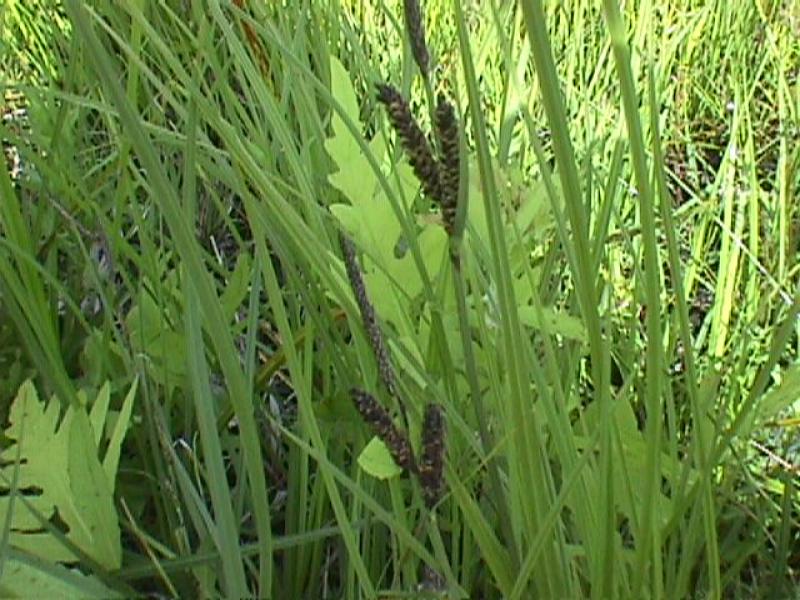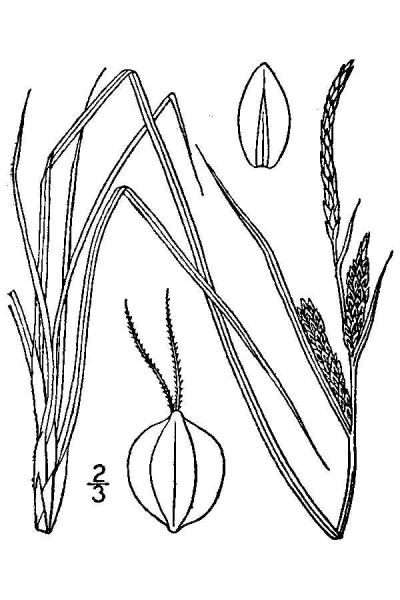Black Sedge
Carex nigra (L.) Reichard
- Class
- Monocotyledoneae (Monocots)
- Family
- Cyperaceae (Sedge Family)
- State Protection
- Endangered
Listed as Endangered by New York State: in imminent danger of extirpation in New York. For animals, taking, importation, transportation, or possession is prohibited, except under license or permit. For plants, removal or damage without the consent of the landowner is prohibited.
- Federal Protection
- Not Listed
- State Conservation Status Rank
- S1
Critically Imperiled in New York - Especially vulnerable to disappearing from New York due to extreme rarity or other factors; typically 5 or fewer populations or locations in New York, very few individuals, very restricted range, very few remaining acres (or miles of stream), and/or very steep declines.
- Global Conservation Status Rank
- G5
Secure globally - Common in the world; widespread and abundant (but may be rare in some parts of its range).
Summary
Did you know?
The specific epithet nigra means black and is probably in reference to the dark purple-brown to black pistillate scales and occasionally black apices of the perigynia.
State Ranking Justification
There is a single, recently discovered extant population, and only one other voucher specimen. About a half-dozen unvouchered reports have been made, but nothing more recent than the early 1900s. Southern New England has apparently experience a significant decline of Carex nigra populations due to land-use changes. The same appears to be true within New York. More survey work is needed at the sites where it was previously reported, as well as other sites that seem to have suitable habitat.
Short-term Trends
Carex nigra was rediscovered in Warren County in 2007. Previous to that it was known only from historical records. So the short-term trend is increasing... but based on very minimal data.
Long-term Trends
There is only one known extant population, and all historical populations except one are based on reports only. One historical population is documented by a voucher specimen. The locality information for this specimen is quite general and relocation of this population has so far not been successful. In southern New England, C. nigra appears to be declining in abundance due to a loss of wet fields and pastures (Standley et al. 2002). Overall, long term trends in New York are not known but may indicate that this species is declining.
Conservation and Management
Threats
No threats are currently known for Carex nigra in New York.
Conservation Strategies and Management Practices
No management is currently needed.
Research Needs
Additional effort should be put into searching for historical populations. Since the locality information for these populations is not precise searches will be difficult.
Habitat
Habitat
Wet, open, and short graminoid dominated habitat including small forested seepage swamps, and wet roadsides, especially near the coast (New York Natural Heritage Program 2006). Wet meadows (Standley et al. 2002). Wet meadows, edges of salt marshes (Haines and Vining). Wet meadows and salt marshes, mostly near the coast (Gleason and Cronquist 1991). Open turfs, swales, gravels, rocks, etc. (Fernald 1970).
Associated Ecological Communities
- Gravel mine*
An excavation in a gravel deposit from which gravel has been removed. Often these are dug into glacial deposits such as eskers or kames. Vegetation may be sparse if the mine is active; there may be substantial vegetative cover if the mine has been inactive for several years. Near-vertical slopes are used by bank swallows for nesting sites.
- High salt marsh*
(guide)
A coastal marsh community that occurs in sheltered areas of the seacoast, in a zone extending from mean high tide up to the limit of spring tides. It is periodically flooded by spring tides and flood tides. High salt marshes typically consist of a mosaic of patches that are mostly dominated by a single graminoid species.
- Maritime freshwater interdunal swales*
(guide)
A mosaic of wetlands that occur in low areas between dunes along the Atlantic coast; the low areas (swales) are formed either by blowouts in the dunes that lower the soil surface to groundwater level, or by the seaward extension of dune fields. Water levels fluctuate seasonally and annually. Sedges and herbs are usually the most abundant types of plants. These wetlands may be quite small (less than 0.25 acre).
- Shallow emergent marsh*
(guide)
A marsh meadow community that occurs on soils that are permanently saturated and seasonally flooded. This marsh is better drained than a deep emergent marsh; water depths may range from 6 in to 3.3 ft (15 cm to 1 m) during flood stages, but the water level usually drops by mid to late summer and the soil is exposed during an average year.
- Successional old field*
A meadow dominated by forbs and grasses that occurs on sites that have been cleared and plowed (for farming or development), and then abandoned or only occasionally mowed.
* probable association but not confirmed.
Range
New York State Distribution
Carex nigra is currently known from one population in Warren County. There are also a few scattered historical populations from the northern parts of central and western New York as well as eastern New York. All of these populations except one from Dutchess County in eastern New York, are from unvouchered reports. New York is at the southern edge of its range.
Global Distribution
Carex nigra occurs in North America, Europe and western Asia. In North America it occurs from Greenland south to Newfoundland, Maine, and Connecticut west to New York, and Quebec. It is also disjunct in Michigan and may be waif at this site (Voss 1972, Standley et al. 2002).
Identification Comments
General Description
Black sedge is a grass-like perennial with long rhizomes and grows in patches. The bases of the plants are red-brown. Leaves are strap-like and 2.0-4.5 mm wide. Its stems are not clustered and are 10-110 cm long. Three to five narrowly cylindrical clusters of flowers/fruits (spikes) occur along and at the apex of the stems. The lower two to four spikes contain female flowers which mature into fruits. The upper one to two spikes are composed of male flowers. Fruits (perigynia) are 2.0-3.7 mm long (Standley et al. 2002).
Identifying Characteristics
Carex nigra is a long rhizomatous colonial perennial. Leaf sheaths are glabrous (at least the proximal ones) and do not become ladder-fibrillose. The basal sheaths are red-brown. Culms are scabrous and 10-110 cm long although they are usually on the short end of this range. Proximal bracts extend to approximately the top of the inflorescences. There are 2-4 lateral erect pistillate spikes 1.2-4.2 cm long and 1-2 terminal staminate spikes. Pistillate scales are dark purple-brown to black often with a slender green mid-stripe. Perigynia are 2.0-3.7 mm long and have a minute beak 0.1-0.2 mm long (Standley et al. 2002).
Best Life Stage for Proper Identification
It is easiest to identify Carex nigra when it has almost mature to mature perigynia. Full plants including basal leaves are helpful for identification and should be collected.
Similar Species
Carex nigra is a fairly distinctive species and should not be easily confused with other species. The dark pistillate scales, bracts equal to inflorescences, and colonial habit are helpful characters to distinguish C. nigra.
Best Time to See
Immature perigynia start to form in early July. These mature and persist into August although later in the season the perigynia start to shed. Therefore, the best time to survey for this species is from July till mid-August.
- Fruiting
The time of year you would expect to find Black Sedge fruiting in New York.
Black Sedge Images
Taxonomy
Black Sedge
Carex nigra (L.) Reichard
- Kingdom Plantae
- Phylum Anthophyta
- Class Monocotyledoneae
(Monocots)
- Order Cyperales
- Family Cyperaceae (Sedge Family)
- Order Cyperales
- Class Monocotyledoneae
(Monocots)
- Phylum Anthophyta
Additional Common Names
- Sedge
Synonyms
- Carex acuta var. nigra L.
- Carex nigra var. strictiformis (L.H. Bailey) Fernald
- Carex vulgaris var. strictiformis L.H. Bailey
- Carex x aquanigra B. Boivin
Comments on the Classification
Carex nigra is currently placed in section Phacocystis. It was formerly placed in section Acutae but the latter group is no longer considered distinct. Carex nigra is a member of the C. acuta group which includes C. lenticularis. Carex nigra can be variable but currently it is not separable into distinct taxa. Carex nigra is known to hybridize with a few other members of section Phacocystis including C. stricta, C. aquatalis, and C. paleacea. Carex recta is the stabilized hybrid between C. nigra and C. paleacea. It is not known from New York (Standley et al. 2002).
Additional Resources
Best Identification Reference
Standley, L.A., J. Cayouette, and L. Bruederle. 2002. Carex Linnaeus sect. Phacocystis Dumortier. Pages 379-401 in Flora of North America Editorial Committee (editors), Flora of North America, North of Mexico, Volume 23, Magnoliophyta: Commelinidae (in part): Cyperaceae. Oxford University Press, New York, NY, USA. 608pp + xxiv.
Other References
Fernald, M.L. 1950. Gray's manual of botany. 8th edition. D. Van Nostrand, New York. 1632 pp.
Gleason, Henry A. and A. Cronquist. 1991. Manual of Vascular Plants of Northeastern United States and Adjacent Canada. The New York Botanical Garden, Bronx, New York. 910 pp.
Haines, A. and T.F. Vining. 1998. Flora of Maine, A Manual for Identification of Native and Naturalized Vascular Plants of Maine. V.F.Thomas Co., Bar Harbor, Maine.
Holmgren, Noel. 1998. The Illustrated Companion to Gleason and Cronquist's Manual. Illustrations of the Vascular Plants of Northeastern United States and Adjacent Canada. The New York Botanical Garden, Bronx, New York.
New York Natural Heritage Program. 2024. New York Natural Heritage Program Databases. Albany, NY.
Reschke, Carol. 1990. Ecological communities of New York State. New York Natural Heritage Program, New York State Department of Environmental Conservation. Latham, NY. 96 pp. plus xi.
Voss, E.G. 1972. Michigan Flora, Part I. Gymnosperms and Monocots. Cranbrook Institute of Science Bulletin 55 and the University of Michigan Herbarium. Ann Arbor. 488 pp.
Weldy, T. and D. Werier. 2010. New York flora atlas. [S.M. Landry, K.N. Campbell, and L.D. Mabe (original application development), Florida Center for Community Design and Research http://www.fccdr.usf.edu/. University of South Florida http://www.usf.edu/]. New York Flora Association http://newyork.plantatlas.usf.edu/, Albany, New York
Links
About This Guide
Information for this guide was last updated on: May 31, 2006
Please cite this page as:
New York Natural Heritage Program. 2024.
Online Conservation Guide for
Carex nigra.
Available from: https://guides.nynhp.org/black-sedge/.
Accessed July 26, 2024.

